Key takeaways:
- Guest miscommunication often arises from unclear expectations, logistical misunderstandings, and dietary preferences.
- Utilizing clarity in event communication, including detailed invitations and proactive follow-ups, can significantly reduce misunderstandings.
- Active listening and timely updates are crucial techniques for addressing and resolving miscommunication during events.
- Implementing visual aids and facilitating a welcoming environment enhances guest experience and minimizes confusion.
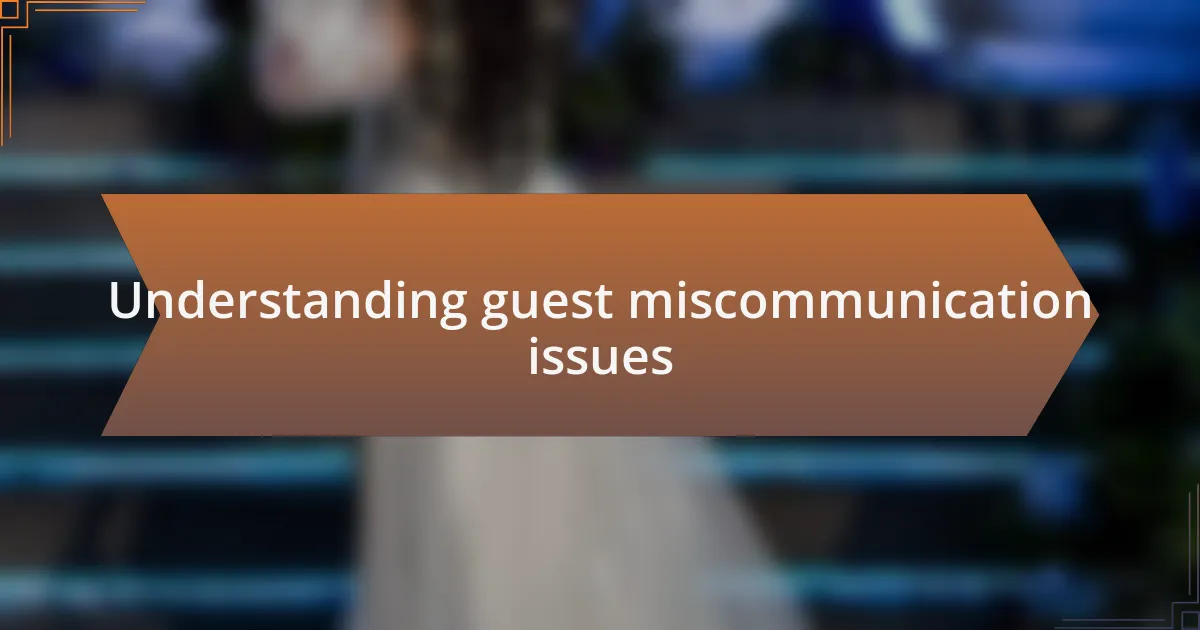
Understanding guest miscommunication issues
Guest miscommunication issues can often stem from unclear expectations and varying interpretations of information. For instance, I once encountered a situation where a client assumed a venue had specific amenities without confirming them, which led to disappointment on the event day. How often do we assume others understand us just because we’re on the same page?
Another layer to this miscommunication can be timestamps and deadlines. I recall planning a wedding where a guest mistook the RSVP deadline, thinking it was one week longer than it actually was. This kind of misunderstanding can cause a ripple effect, impacting menu choices and seating arrangements. It begs the question: how crucial is it to emphasize these details when communicating, especially in written form?
Finally, the emotional weight behind these conversations shouldn’t be underestimated. When a guest feels sidelined or overlooked due to miscommunication, it can lead to feelings of frustration or resentment. I always try to remember that clarity isn’t just about the information but also about making guests feel valued and understood. After all, isn’t that the essence of event management?
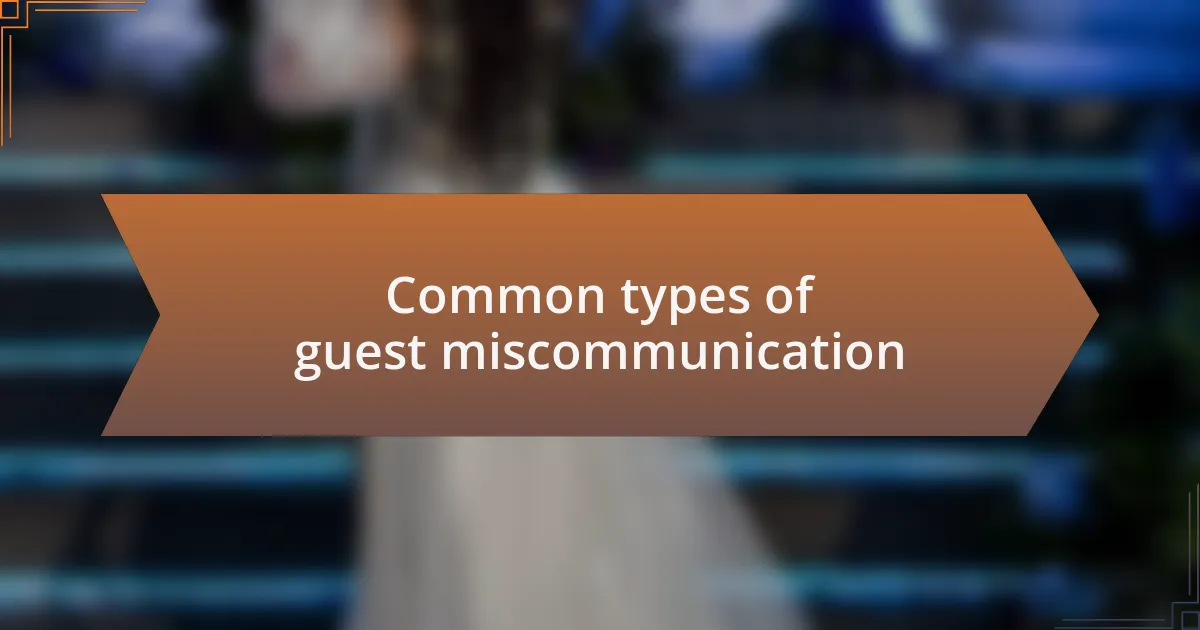
Common types of guest miscommunication
Miscommunication often arises from ambiguous wording in invitations or event details. I vividly remember an event where we labeled an event as “formal attire” without specifying further. Some guests arrived in tuxedos while others came in cocktail dresses, leading to an awkward atmosphere. It makes me wonder: how often do we take for granted that our guests will interpret our messages correctly?
Another frequent source of confusion is logistics. At one particular corporate event, I had a guest mistakenly think the location was the office instead of the venue we had booked. Their expectation delay not only caused them stress but impacted their mood throughout the evening. It’s interesting how one small detail can spiral into a bigger issue—shouldn’t we strive for clarity in our instructions to prevent such scenarios?
Lastly, dietary preferences can become a tangled web of miscommunication. I recall taking meticulous notes on meal choices, but when the dishes arrived, a few vegetarians were served meat meals. The guests felt overlooked and uncomfortable, which is a situation I wouldn’t wish on anyone organizing an event. It raises an essential question: how can we better ensure that everyone’s needs are acknowledged and met in our planning processes? Clearly, listening and confirming details can go a long way in bridging these gaps.
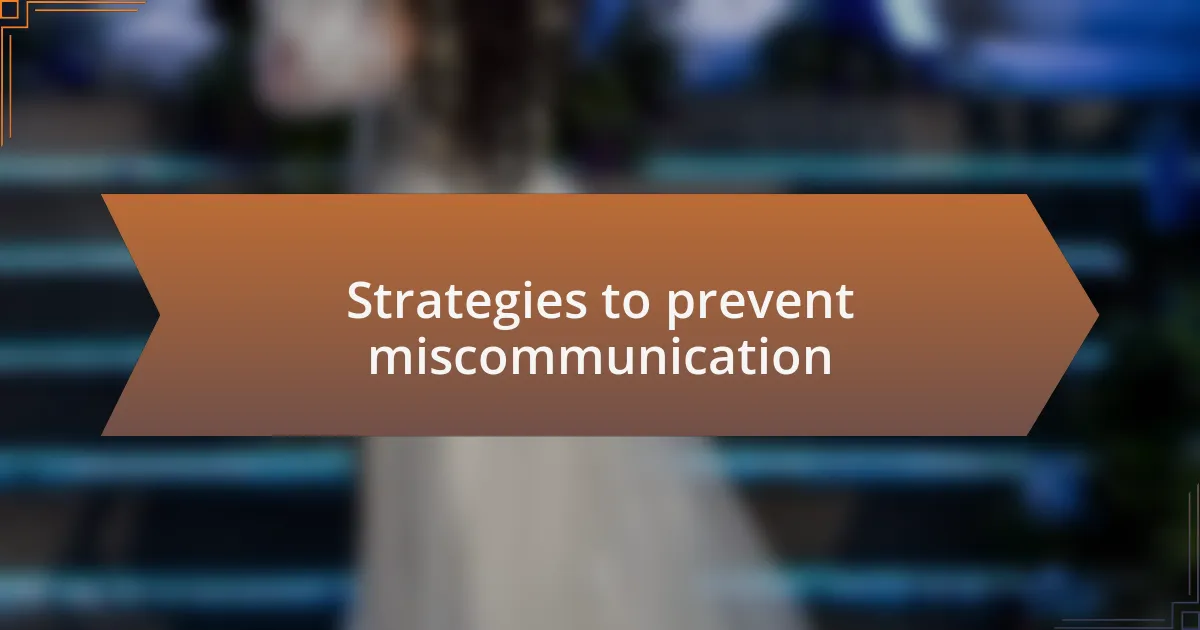
Strategies to prevent miscommunication
To prevent miscommunication, clarity in communication is essential. I always emphasize the importance of being detailed in event invitations. For instance, when planning a themed gala, I crafted a comprehensive guide that described not only the event’s theme but also specific suggestions for attire and behavior. By going the extra mile, I not only eased any uncertainty but also created excitement among guests. Isn’t it fascinating how a little detail can enhance the overall experience?
Another strategy involves proactive verification. Just like checking your to-do list, I make a habit of following up with guests before the event. Once, I noticed a guest was confused about our open bar arrangement; they thought drinks would be included with the ticket price. A quick phone call clarified it and also removed any potential anxiety they were feeling. How often do we assume that all our guests are on the same page when, in reality, they might have lingering questions?
Lastly, I find that using technology can be a game-changer in minimizing misunderstandings. During one recent event, we created a dedicated webpage where guests could find all the information they needed: from directions to FAQs. Feedback was overwhelmingly positive, with many saying they appreciated the convenience of having everything in one place. Isn’t it empowering to see how the right tools can foster better communication and enhance the guest experience?
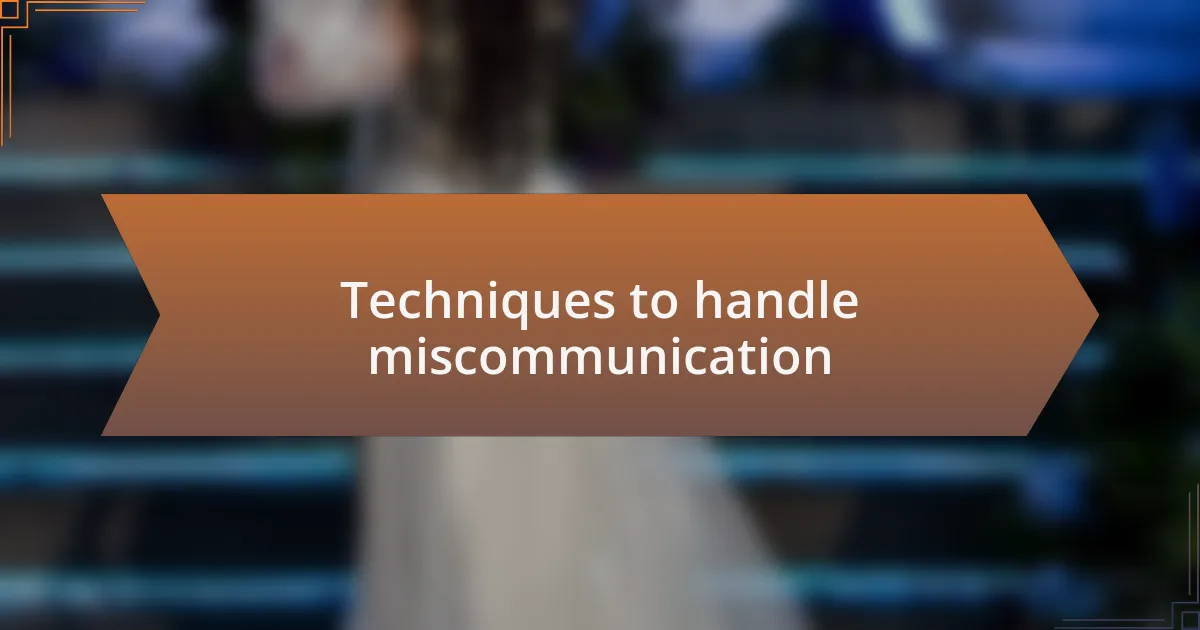
Techniques to handle miscommunication
One effective technique I’ve found is utilizing visual aids to clarify information. At a recent outdoor wedding, I set up clear signage to guide guests to different locations, like the ceremony, cocktail hour, and reception. As I watched guests easily navigate the venue, I couldn’t help but feel a sense of pride knowing that these little visual cues reduced confusion and enhanced their experience.
Active listening is another vital method I prioritize. During pre-event meetings, I make it a point to ask open-ended questions and encourage guests to express any concerns or expectations. There was a time when a guest mentioned feeling anxious about dietary restrictions; I listened closely, which led us to create a tailored menu that not only accommodated her needs but also made her feel valued and considered. How often do we overlook this simple act of care?
Finally, I emphasize the importance of timely updates. After all, in our fast-paced world, information can change quickly. During a corporate event, for example, we had to adjust the schedule due to weather conditions. Sending out text alerts to keep everyone informed was crucial; I could almost feel the collective relief when attendees received the information promptly. Isn’t it amazing how a few timely words can quell uncertainty and keep everyone on track?
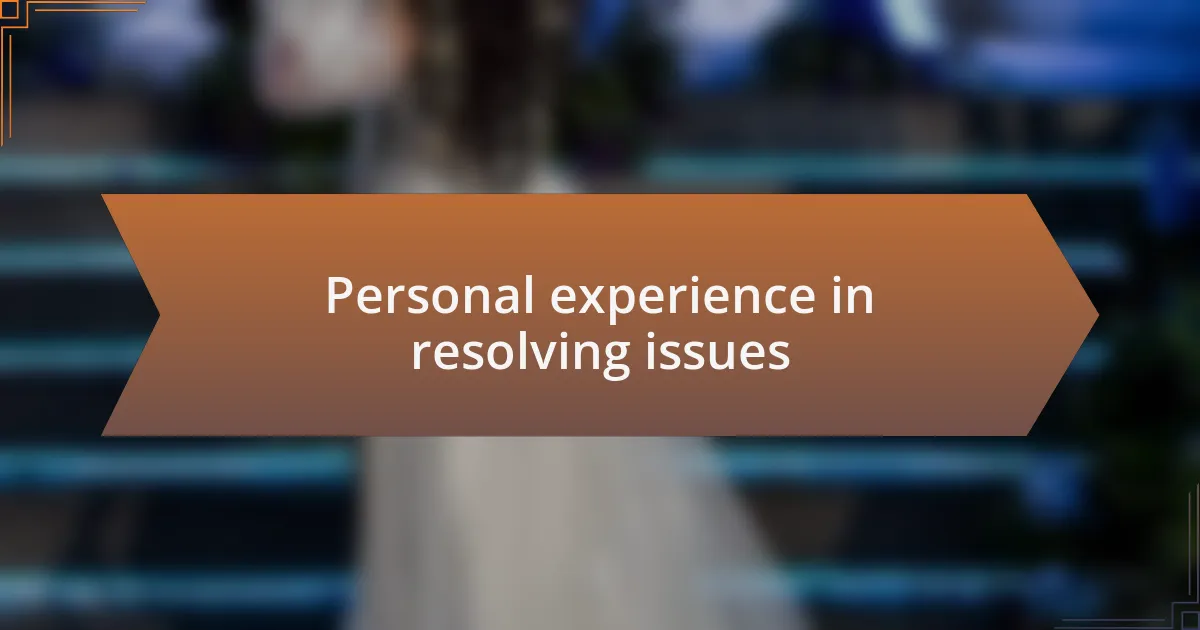
Personal experience in resolving issues
In my experience, miscommunication often arises from assumptions. Once, during an event planning phase, a client assumed all guests would automatically know the itinerary. They hadn’t shared details about activities and times, which led to some confusion on the big day. After realizing this, I took a proactive approach by creating a printed itinerary for each guest, which not only clarified important details but also brought a sense of reassurance.
I remember a situation where a misunderstanding over a venue’s layout caused anxiety for both the guests and the coordinators. I could sense the tension when attendees struggled to find their assigned areas. In that moment, I quickly gathered a small team to assist those in need, providing personal direction. It was rewarding to see faces light up when they received help, reinforcing my belief in the power of immediate, personal intervention.
Another noteworthy experience involved catering arrangements. A last-minute change to the menu had upset a few guests who were unaware of the specific alternatives. I took the initiative to approach them directly, explaining the situation and offering personal recommendations. It turned into an open dialogue that not only eased their concerns but also sparked a sense of camaraderie among guests. Isn’t it remarkable how a simple conversation can transform an uncomfortable situation into a shared experience?
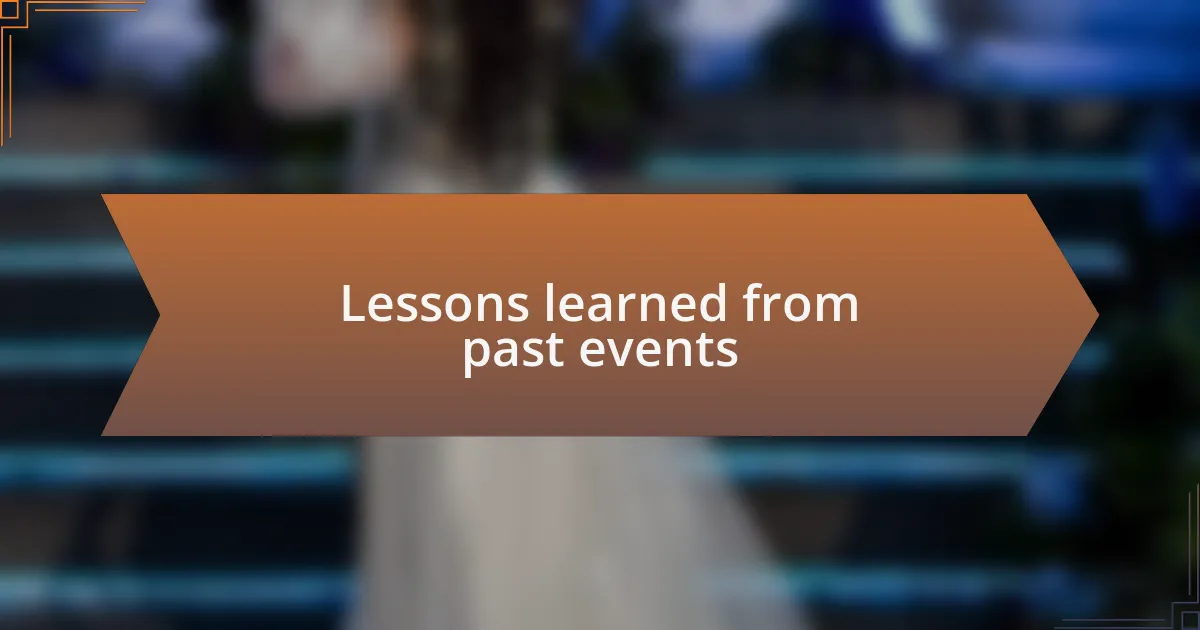
Lessons learned from past events
Reflecting on previous events, I’ve learned that communication isn’t just about sharing information; it’s about ensuring the message is received and understood. At one event, we overlooked the need for clear signage, and I watched as guests wandered in circles, visibly frustrated. This experience taught me the importance of visual aids—now, I always prioritize clear directional signage to guide attendees effortlessly and minimize confusion.
There was a particular instance where a scheduling mix-up led to conflicting sessions. I felt the weight of disappointment in the air when I realized that guests had come to hear different keynote speakers simultaneously. This taught me a valuable lesson in organizing a clear, cohesive agenda and regularly updating all stakeholders. Ensuring everyone is on the same page is crucial—after all, who enjoys missing out on valuable experiences?
Another challenge arose during a networking session, where many guests felt shy to mingle. Watching people standing alone rather than engaging was disheartening. It grasped my attention that creating a welcoming environment is essential; I’ve since incorporated icebreakers and facilitated introductions, fostering a sense of community and making everyone feel included. By transforming the atmosphere, I’ve seen how quickly barriers break down. Have you ever noticed how a simple gesture can change the dynamics of an entire event?